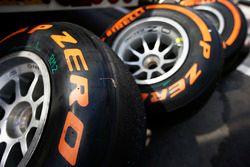FIA to ramp up tyre pressures investigations from Monaco GP
The FIA is ramping up its investigations about tyre pressures from the Monaco Grand Prix, amid suspicions that some Formula 1 teams are using clever technology to get around restrictions.

Photo by: GP2 Media Service










Ever since last year's Italian Grand Prix, the FIA has mandated a minimum starting pressure for the tyres in a bid to minimise the chances of teams suffering problems.
With these pressures being much higher than teams would ideally like, there are clear benefits for teams that can lower the pressure after the official measurements have been taken.
Suspicions from some teams that rivals are using tricks – such as heating wheels or using double chambers in the rims – prompted McLaren earlier this month to ask for a clarification about what it could do.
The FIA made it clear that double chambered rims were not within the rules and, as part of a deeper investigation to check what teams are up, the governing body has told teams that it will now be keeping a closer eye on what they are doing.
Motorsport.com has learned that from the next race, the teams must now arrange for their tyre pressures to be sent to the FIA's Standard Data Recorder over standard CAN (Control Area Network) cable system.
In a document sent to teams, the FIA says that the pressures have to be recorded as standard Psi and in an unmodified form from those that are sent to the team's telemetry.
The change will not open the door for any team to be punished if its tyre pressures drop dramatically after the starting pressures have been recorded, but it will allow the FIA to gain a better understanding of what teams are up to.
The likelihood is that if the FIA discovers that some teams are behaving in a way that it is not happy with, then it could open the door to a clampdown or a change in the way pressures are policed.
When asked if he believed teams were playing around with pressures, Pirelli motorsport director Paul Hembery said: "Often when we are being told we have increased the [starting] pressure by 3-4Psi, we don't see 3-4 Psi when the cars are starting. It is probably around half of that. So something is happening."
Although the suspicions about some teams doing this have only surfaced in the last few weeks, Hembery suggested that the situation has been developing for a much longer time.
"Maybe the first signals were last year," he said.
Tough job
Williams technical chief Pat Symonds believes that the FIA faced a tough job in trying to control the area of tyre pressures, as implementing a running pressure limit would not be easy.
"The trouble is that the tyre pressure sensors are good but not perfect, and the electronics that are in them, we actually run them above the temperature that the electronics should run at," he explained.
"So consequently we do get failures on them. The reliability is not as good as it should be. If it becomes a regulatory thing: what happens then? Are we going to see a lot more failures? That is quite a cynical view but you might do, mightn't you?"
He added: "If it is to be a regulatory thing, then it has to be a prescribed device. So there is a long way to go. Some teams make their own sensors because there are two basic ones on the market and both of them suffer a little bit with heat, but I know some teams do their own."
The reliability doubts about the sensors were proved on Friday when Renault's sensor on the tyre that blew up on Palmer's car locked at 19.6Psi, even after it had deflated.
Hembery added: "It was the last signal it gave before the tyre gave up. 19.5 is the minimum."
Be part of Motorsport community
Join the conversationShare Or Save This Story
Subscribe and access Motorsport.com with your ad-blocker.
From Formula 1 to MotoGP we report straight from the paddock because we love our sport, just like you. In order to keep delivering our expert journalism, our website uses advertising. Still, we want to give you the opportunity to enjoy an ad-free and tracker-free website and to continue using your adblocker.















Top Comments